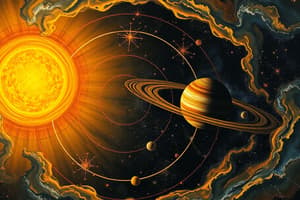Podcast
Questions and Answers
تسار الكواكب في المجموعة الشمسية على مدارات شبه بيضاوية حول الشمس.
تسار الكواكب في المجموعة الشمسية على مدارات شبه بيضاوية حول الشمس.
False (B)
Flashcards are hidden until you start studying
Study Notes
The Solar System: Number of Planets, Orbiting Bodies, and Solar Energy Source
The solar system is a vast collection of celestial bodies that revolve around the central star, the Sun. Here, we delve deeper into the intricacies of the solar system, discussing the number of planets, the role of the sun as both a light source and a heat source, planetary orbits, and the overall composition of the system.
Number of Planets
The solar system comprises eight primary planets: Mercury, Venus, Earth, Mars, Jupiter, Saturn, Uranus, and Neptune. Additionally, there are five recognized dwarf planets: Ceres, Pluto, Haumea, Makemake, and Eris. These celestial bodies, along with countless asteroids and comets, contribute to the diverse makeup of the solar system.
Sun as Light Source
As the centerpiece of the solar system, the Sun emits electromagnetic radiation across the entire electromagnetic spectrum. Visible light is just one component of this complex emission. The Sun is the primary light source within our solar system, illuminating each planet and enabling life on Earth.
Sun as Heat Source
Beyond providing light, the Sun serves as a crucial heat source for the planets in the solar system. Its intense nuclear reactions generate vast amounts of thermal energy, which radiates across space and warms up planets within its vicinity. The balance between incoming sunlight and planetary albedo determines the surface temperatures of different planets.
Planetary Orbits
Planetary orbits refer to the paths followed by planets as they orbit around a central body, typically a star. In our solar system, all planets follow elliptical orbits around the Sun, meaning their orbits are not perfectly circular. Each planet's orbit is influenced by the gravitational forces exerted by other planets and their moons, resulting in varying orbital distances and velocities.
Composition of the Solar System
The solar system is primarily composed of matter from a protostar, which experienced a supernova explosion approximately 4.6 billion years ago. The remaining stellar debris coalesced into the Sun, while the surrounding gas and dust clouds condensed into the planets and other celestial bodies. The solar system contains a variety of elements, including hydrogen, helium, oxygen, carbon, nitrogen, iron, gold, and uranium, reflecting the cosmic evolution and diversity present since its formation.
Studying That Suits You
Use AI to generate personalized quizzes and flashcards to suit your learning preferences.



